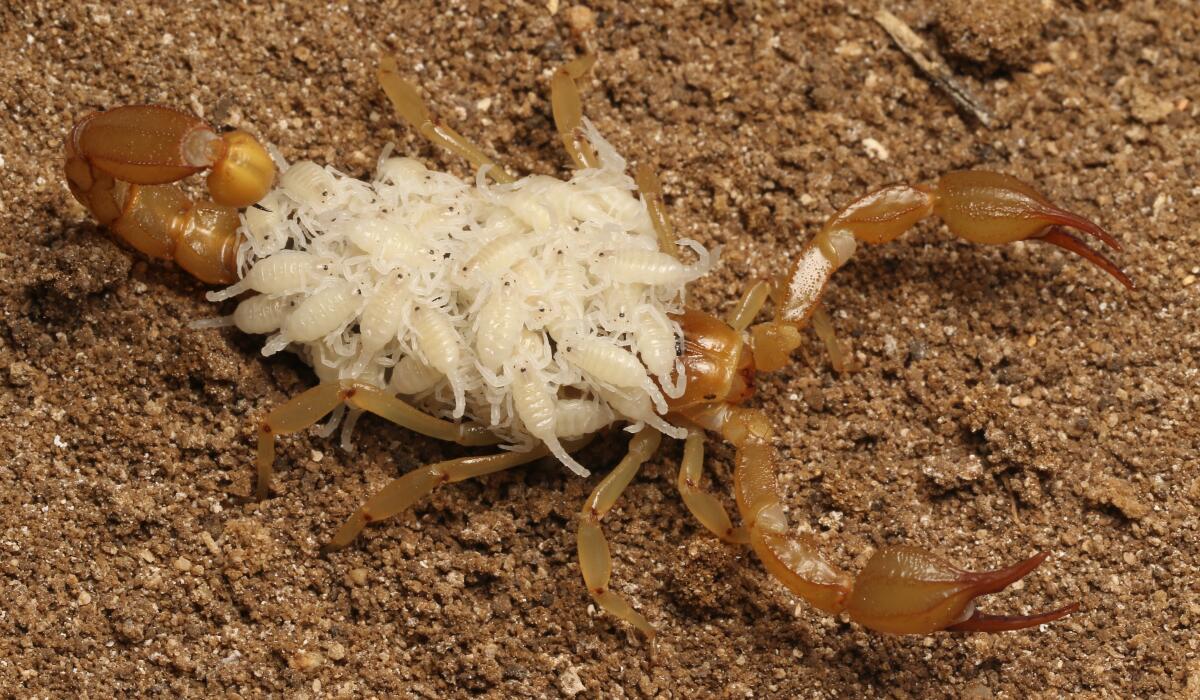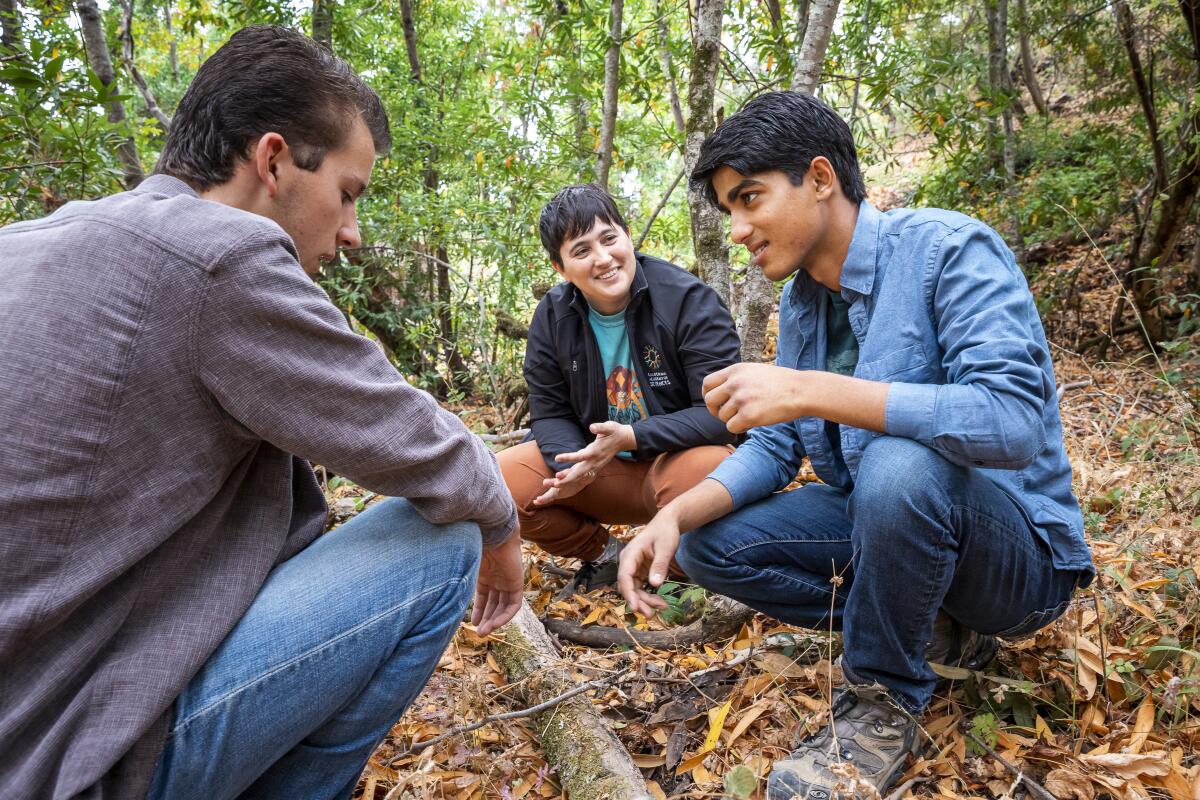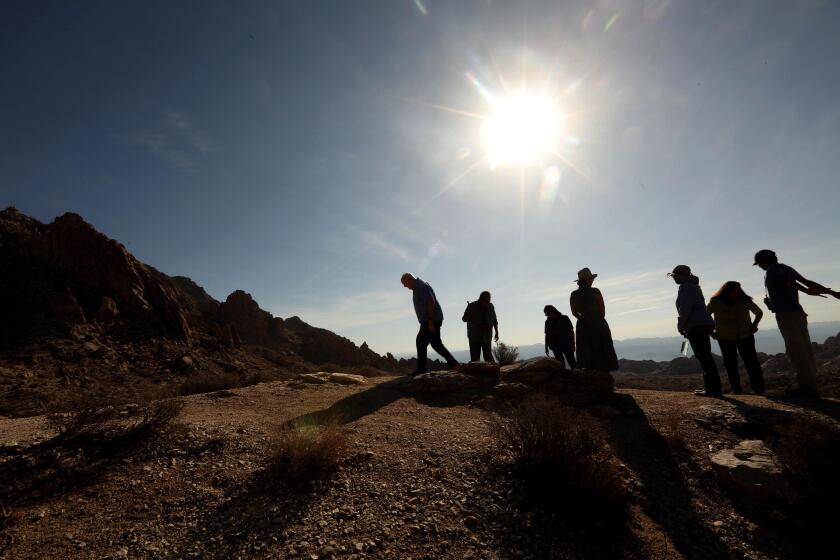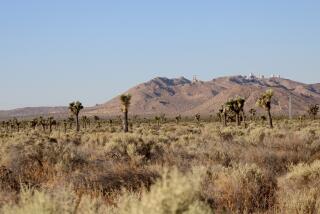2 Bay Area students discover 2 new scorpion species, but worry about the arachnids’ survival

- Share via
On a warm, moonless spring evening, a secretive male scorpion set out for an evening walk along the floor of one of California’s most desolate playas in search of food, or maybe even love.
But while scurrying across the salty clay soil of Soda Lake in San Luis Obispo County, the arachnid bumped into some rare visitors: a pair of Bay Area high school students waving ultraviolet flashlights. As their beams flashed over the predator’s armored flesh, the creature glowed an eerie neon blue.
And, just like that, one of California’s most elusive scorpions finally ended its epic game of hide-and-seek.
For centuries, Native Americans have visited Avi Kwa Ame, or Spirit Mountain, to seek religious visions and give thanks for the bounty of the Earth.
The scorpion-loving students, Prakrit Jain, 18, of Los Altos, and Harper Forbes, 19, of neighboring Sunnyvale, had been drawn to the rugged Carrizo Plain by a photo of a nameless and unique-looking scorpion posted to the website iNaturalist.
“As soon as we turned our flashlights on and saw it in reality, we knew immediately that this was an undescribed species,” Jain said of the May 2021 discovery. “It really looked very different from any other we had seen before.”
Specifically, it was larger than other scorpions of its genus, and its trunk and tail carried a darker hue.
They scooped up the scorpion and several others in vials, hopped into Jain’s mom’s Honda Pilot, and drove along the bumpy dirt road back to camp.
Soon, with the help of Lauren Esposito, an arachnologist at the California Academy of Sciences, they determined that this previously unknown species has likely existed along the ragged edge of the San Andreas fault for tens of thousands of years. They dubbed it Paruroctonus soda, a literal reference to the lake it calls home.
But the pair weren’t quite done discovering new species.
A few months later, the students trekked into the Mojave Desert in Kern County where they found another hidden species of scorpion, living within a small patch of land, along the rim of a similar playa. They named this species Paruroctonus conclusus, a reference to the Latin word for restricted, closed or confined, describing its small, fragile habitat.
Their findings were published recently in the journal ZooKeys, where the authors argued that the Mojave Desert species should be regarded as endangered due to its limited range.
Today, Jain and Forbes are first-year college students at UC Berkeley and the University of Arizona, respectively. Despite their busy schedules, they say they remained concerned about the survival of their discoveries.
Both P. soda and P. conclusus rely on the soft, alkaline-rich, clay soil found near the edge of playas to burrow into, and their survival depends on these playa conditions. But as global warming worsens and exacerbates California’s historic drought, conditions threaten to sap precious moisture from the soil and imperil the scorpions.
Development also poses a threat.
Although P. soda’s home is a part of the Carrizo Plain National Monument and is protected from development, P. conclusus’ home falls within a small area of Bureau of Land Management property that is open to mining. It is also close to a pair of renewable energy projects.

A paper by Jain, Forbes and Esposito highlights two solar farms near Koehn Lake: the Beacon Solar Project, which is owned by the Los Angeles Department of Water and Power, and Springbok Solar Farm, which contracts with the DWP and also sends power to the city’s grid. A few miles south is the new Eland Solar Project, which, when completed sometime in 2023, will also send its power to the city’s grid. Nearby are small farms and towns that the study said are projected to grow in population over the next two decades.
“These factors significantly threaten the habitat of Paruroctonus conclusus … not only by direct habitat alteration but also by indirect downstream effects such as production of waste products, usage of groundwater, and possible alterations to the region’s hydrology,” the trio wrote in their study.
There is precedent for development on California’s playas, Esposito added, pointing to Lake Harper, another playa in the Mojave, about 70 miles south of Koehn Lake, where in the 1980s developers built one of the world’s largest solar power plants, and another plant in 2014.
“We urge the [Bureau of Land Management] to consider creating a conservation area for P. conclusus ... and work towards reducing external threats to its habitat,” the study said.
A spokesperson for DWP said their projects comply with all federal and state environmental permitting and review requirements, including the health of species that are protected by law. DWP said there are no pending or proposed projects near Koehn Lake at this time.
8minute Solar Energy, which owns the Springbok farm and is developing the Eland project, said it works closely with statewide agencies and environmental groups in making sure their projects have “minimal impact to wildlife.” They said they disagree with the “conclusions of the study as 8minute’s solar projects are not within suitable habitats for the species, as defined by the study itself.”
Wind turbines, solar panels and power lines are needed to confront climate change. But they’re also reshaping the West — and not always for the better.
Although most Californians may care little about the survival of scorpions, ecologists say the demise of any species indicates a larger, more wide-reaching imbalance within an ecosystem. Such is the case with deserts, said Cameron Barrows, an ecologist and retired professor at UC Riverside who still conducts research on the Mojave Desert from the school’s Palm Desert Center.
“You talk about deserts as an adjective when referring to food deserts or cultural deserts because there’s not much food or there’s not much culture, and so deserts have developed this aura in our human culture that there is very little biodiversity here,” Barrows said. “Surely the opposite is true.”
After tropical forests, he said, deserts are the most biodiverse ecosystems on the planet, in terms of animals and plants.
“Humans are dependent on biodiversity, and if we reduce biodiversity, we are reducing our opportunities to survive on this planet,” Barrows said. “And scorpions, along with other wildlife, are indicators of the extreme levels of biodiversity that the desert has.”
Successful conservation efforts focused on scorpions remain rare however.

The only scorpion species that have made the International Union for Conservation of Nature’s Red List of Threatened Species are a small number of species from Africa that are primarily harvested for pet trades.
“So in terms of protection of scorpions as a result of habitat destruction or potential habitat destruction, there’s no historic precedent anywhere in the world for protection of scorpion species,” Esposito said.
In the meantime, conservation for Jain and Forbes, who are both studying biology, comes in the form of continuing their nighttime expeditions in search of new scorpion species.
The work isn’t without risk however. Forbes has been stung over 50 times, Jain even more. With no known deadly species of scorpion native to California, most stings are forgetful. Though Jain carries an epinephrine pen on him just in case.
The two are normally in control of the arachnids, either scooting them into vials or, pinching the last segment of their tail, which Forbes said renders them defenseless.
On one trip deep into the Mojave Desert however, Forbes recalled a sting from a desert hairy scorpion that caused him to lose function of his arms and legs. He felt numbness and extreme tingling. His abdominal muscles started contracting.
Forbes and his mother eventually made their way out of the desert and found a hotel where he was able to sleep off the symptoms. The following day, he still felt some residual effects. Even after consulting with experts, he was never sure whether the normally harmless sting caused the reaction.
When Forbes and his mother arrived home, it was with fewer specimens than he had hoped. After the sting, he had decided to leave that particular scorpion on the desert floor.
More to Read
Sign up for Essential California
The most important California stories and recommendations in your inbox every morning.
You may occasionally receive promotional content from the Los Angeles Times.
















